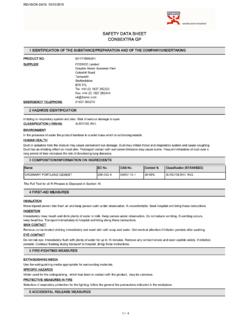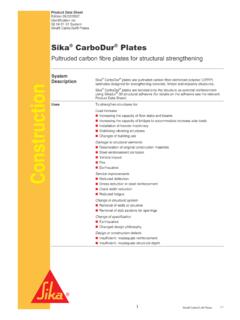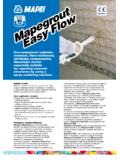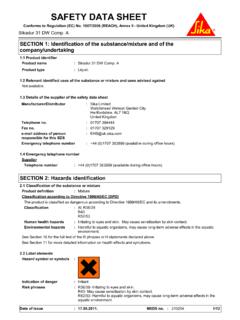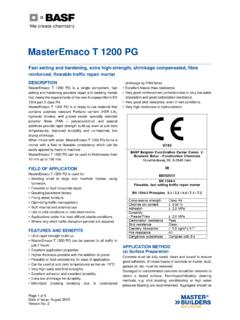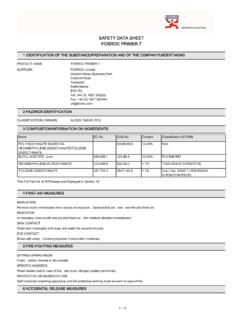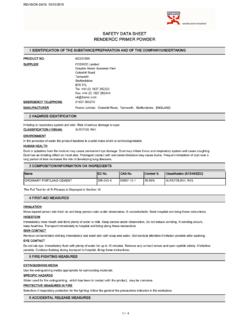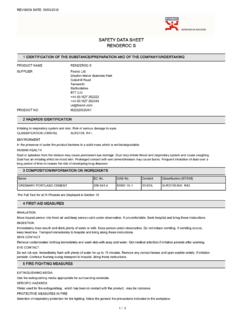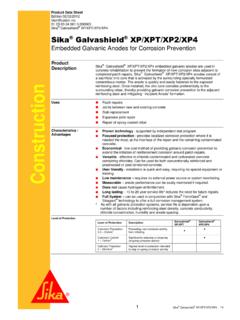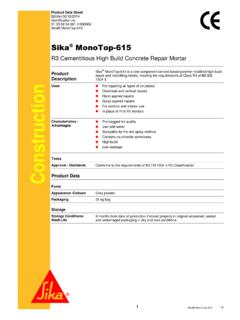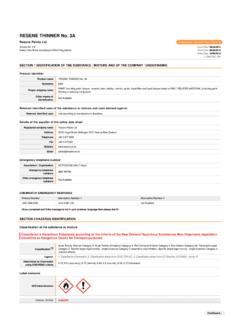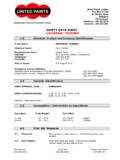Transcription of SAFETY DATA SHEET FOSROC THINNER/CLEANER
1 Revision Date 25 June 2014 Revision 6 SAFETY data SHEET FOSROC thinner /CLEANERSECTION 1: IDENTIFICATION OF THE SUBSTANCE/MIXTURE AND OF THE Product identifierProduct nameFOSROC thinner /CLEANERP roduct Relevant identified uses of the substance or mixture and uses advised againstIdentified usesCleaning solvent Paint Details of the supplier of the SAFETY data sheetFOSROC LimitedSupplierDrayton Manor Business ParkColeshill RoadTamworthStaffordshireB78 3 XNTel. +44 (0) 1827 262222 Fax. +44 (0) 1827 Emergency telephone number+44 (0) 1827 265 279 ( to Mon - Thu; to Fri)SECTION 2: HAZARDS Classification of the substance or mixtureClassification (1999/45/EEC)Xn;R65. Xi;R37. N;R51/53. R10, R66, healthThe liquid may irritate the skin, the eyes and the respiratory product contains a substance which is toxic to aquatic organisms and which may cause long term adverse effects in the aquatic and Chemical HazardsThe product may form explosive vapours/air mixtures even at normal room Label elementsContainsSOLVENT NAPHTHAL abellingHarmfulDangerous for the environmentRisk to respiratory to aquatic organisms, may cause long-term adverse effects in the aquatic : may cause lung damage if thinner /CLEANERR66 Repeated exposure may cause skin dryness or may cause drowsiness and PhrasesS37 Wear suitable only in well-ventilated appropriate containment to avoid environmental material and its container must be disposed of as hazardous release to the environment.
2 Refer to special instructions/ SAFETY data swallowed, do not induce vomiting: seek medical advice immediately and show this container or Other hazardsNot Classified as PBT/vPvB by current EU 3: COMPOSITION/INFORMATION ON MixturesSOLVENT NAPHTHA60-100%CAS-No.: 64742-95-6EC No.: 265-199-0 Classification (67/548/EEC)Xn;R65. Xi;R37. N;R51 ,R66, (EC 1272/2008)Flam. Liq. 3 - H226 EUH066 STOT SE 3 - H336, H335 Asp. Tox. 1 - H304 Aquatic Chronic 2 - H411 Registration Number: 01-2119455851-35 The Full Text for all R-Phrases and Hazard Statements are Displayed in Section 4: FIRST AID Description of first aid measuresGeneral informationMove the exposed person to fresh air at once. Get medical attention if any discomfort the exposed person to fresh air at once. Provide rest, warmth and fresh air. When breathing is difficult, properly trained personnel may assist affected person by administering NOT INDUCE VOMITING!
3 NEVER MAKE AN UNCONSCIOUS PERSON VOMIT OR DRINK FLUIDS! If vomiting occurs, keep head low so that stomach content doesn't get into the lungs. Drink plenty of water. Get medical attention immediately! Provide rest, warmth and fresh contactRemove affected person from source of contamination. Remove contaminated clothing. Wash the skin immediately with soap and contactImmediately flush with plenty of water for up to 15 minutes. Remove any contact lenses and open eyelids widely. If irritation persists: Seek medical attention and bring along these Most important symptoms and effects, both acute and delayedGeneral informationThe severity of the symptoms described will vary dependant of the concentration and the length of high concentrations, vapours are anaesthetic and may cause headache, fatigue, dizziness and central nervous system cause discomfort if swallowed. Fumes from the stomach contents may be inhaled resulting in the same symptoms as contactProlonged or repeated contact with skin may cause redness, itching, irritation and thinner /CLEANEREye contactMay cause temporary eye Indication of any immediate medical attention and special treatment neededNo recommendation given, but first aid may still be required in case of accidental exposure, inhalation or ingestion of this chemical.
4 If in doubt, GET MEDICAL ATTENTION PROMPTLY! Treat 5: FIREFIGHTING Extinguishing mediaExtinguishing mediaExtinguish with foam, carbon dioxide, dry powder or water fog. Foam. Dry chemicals, sand, dolomite extinguishing mediaDo not use water jet as an extinguisher, as this will spread the Special hazards arising from the substance or mixtureHazardous combustion productsDuring fire, toxic gases (CO, CO2) are Fire & Explosion HazardsVapours are heavier than air and may spread near ground to sources of Advice for firefightersSpecial Fire Fighting ProceduresAvoid breathing fire vapours. Water spray should be used to cool containers. Cool containers exposed to flames with water until well after the fire is equipment for fire-fightersSelf contained breathing apparatus and full protective clothing must be worn in case of 6: ACCIDENTAL RELEASE Personal precautions, protective equipment and emergency proceduresWear protective clothing as described in Section 8 of this SAFETY data Environmental precautionsDo not discharge into drains, water courses or onto the Methods and material for containment and cleaning upExtinguish all ignition sources.
5 Avoid sparks, flames, heat and smoking. Ventilate. Stop leak if possible without risk. Dam and absorb spillages with sand, earth or other non-combustible material. Collect spillage with shovel, broom or the like and reuse, if possible. Dispose of large amounts of spillage/waste according to agreement with local authorities. Do not allow runoff to sewer, waterway or ground. Inform Authorities if large amounts are Reference to other sectionsFor personal protection, see section 8. For waste disposal, see section 7: HANDLING AND Precautions for safe handlingAvoid spilling, skin and eye contact. Ventilate well, avoid breathing vapours. Use approved respirator if air contamination is above accepted level. Keep away from heat, sparks and open flame. Static electricity and formation of sparks must be prevented. Storage tanks and other containers must be Conditions for safe storage, including any incompatibilitiesStore in tightly closed original container in a dry, cool and well-ventilated place.
6 Keep in original ClassFlammable liquid Specific end use(s)The identified uses for this product are detailed in Section thinner /CLEANERSECTION 8: EXPOSURE CONTROLS/PERSONAL Control parametersSTDSTEL - 15 MinTWA - 8 HrsNameNotes19 ppmWELSOLVENT NAPHTHAWEL = Workplace Exposure NAPHTHA (CAS: 64742-95-6)DNELP rofessionalDermalSystemic Effects25mg/ Effects150mg/m3 ConsumerOralSystemic Effects11mg/ Effects32mg/m3 ConsumerDermalSystemic Effects11mg/ Exposure controlsProtective equipmentProcess conditionsUse engineering controls to reduce air contamination to permissible exposure level. Provide eyewash measuresProvide adequate general and local exhaust equipmentIf ventilation is insufficient, suitable respiratory protection must be respiratory equipment with gas filter, type protectionUse protective gloves. Nitrile gloves are recommended, but be aware that the liquid may penetrate the gloves.
7 Frequent change is protectionWear approved SAFETY ProtectionWear appropriate clothing to prevent any possibility of liquid contact and repeated or prolonged vapour measuresDO NOT SMOKE IN WORK AREA! Wash hands at the end of each work shift and before eating, smoking and using the toilet. Promptly remove any clothing that becomes contaminated. Wash promptly with soap & water if skin becomes contaminated. Use appropriate skin cream to prevent drying of skin. When using do not eat, drink or 9: PHYSICAL AND CHEMICAL Information on basic physical and chemical propertiesAppearanceClear in waterInitial boiling point and boiling range ( C)140 - 200 CRelative - 15 CVapour density (air=1)>1 Vapour pressure<1 kPa 20 CEvaporation acetate = 194/ FOSROC - cSt at 20 CFlash point ( C)>35 CAuto Ignition Temperature ( C)>400 CFlammability Limit - Lower(%) Limit - Upper(%)7% Other informationVolatile Organic Compound (VOC)800 g/litreSECTION 10: STABILITY AND ReactivityNo specific reactivity hazards associated with this Chemical stabilityStable under normal temperature Possibility of hazardous reactionsNone PolymerisationWill not Conditions to avoidAvoid heat, flames and other sources of Incompatible materialsMaterials To AvoidStrong oxidising Hazardous decomposition productsNone under normal 11.
8 TOXICOLOGICAL Information on toxicological effectsInhalationIn high concentrations, vapours may irritate throat and respiratory system and cause coughing. In high concentrations, vapours are anaesthetic and may cause headache, fatigue, dizziness and central nervous system of the product aspirated into the lungs through ingestion or vomiting may cause a serious chemical pneumonia. May cause discomfort if contactActs as a defatting agent on skin. May cause cracking of skin, and eczema. Prolonged or repeated exposure may cause severe irritation. Repeated and/or prolonged contact may lead to dermatitisEye contactMay cause temporary eye OrgansSkin Eyes Respiratory system, lungsToxicological information on thinner /CLEANERSOLVENT NAPHTHA (CAS: 64742-95-6)Acute toxicity:Acute Toxicity (Oral LD50)> 3592 mg/kg RatAcute Toxicity (Dermal LD50)> 3160 mg/kg RabbitAcute Toxicity (Inhalation LC50)> mg/l (vapours) Rat 4 hoursSkin Corrosion/Irritation:Based on available data the classification criteria are not eye damage/irritation:Based on available data the classification criteria are not or skin sensitisation:Not on available data the classification criteria are not cell mutagenicity:Based on available data the classification criteria are not :This substance has no evidence of carcinogenic Toxicity:Based on available data the classification criteria are not target organ toxicity - single exposure.
9 STOT - Single exposureNot OrgansRespiratory system, lungsSpecific target organ toxicity - repeated exposure:Not classified as a specific target organ toxicant after repeated hazard:May be fatal if swallowed and enters 12: ECOLOGICAL INFORMATIONE cotoxicityThe product contains substances which are toxic to aquatic organisms and which may cause long term adverse effects in the aquatic ToxicityEcological information on NAPHTHA (CAS: 64742-95-6)Acute Toxicity - Fish96 hours mg/l Onchorhynchus mykiss (Rainbow trout)Acute Toxicity - Aquatic Invertebrates48 hours mg/l Daphnia magna96/ FOSROC Persistence and degradabilityDegradabilityThe product is expected to be information on NAPHTHA (CAS: 64742-95-6)BiodegradationWater Degradation (78%) 28 daysThe substance is readily Bioaccumulative potentialBioaccumulative potentialNo data available on Mobility in soilMobility:The product contains organic solvents which will evaporate easily from all surfaces.
10 The product is insoluble in water and will spread on the water Results of PBT and vPvB assessmentNot Classified as PBT/vPvB by current EU information on NAPHTHA (CAS: 64742-95-6)Not Classified as PBT/vPvB by current EU Other adverse effectsNone 13: DISPOSAL CONSIDERATIONSG eneral informationWaste is suitable for incineration. Waste is classified as hazardous waste. Disposal to licensed waste disposal site in accordance with the local Waste Disposal Waste treatment methodsDispose of waste and residues in accordance with local authority requirements. Make sure containers are empty before discarding (explosion risk).SECTION 14: TRANSPORT UN numberUN No. (ADR/RID/ADN)1268UN No. (IMDG)1268UN No. (ICAO) UN proper shipping nameProper Shipping NamePETROLEUM PRODUCTS, (SOLVENT NAPHTHA) Transport hazard class(es)ADR/RID/ADN Class3 ADR/RID/ADN ClassClass 3: Flammable Label Class397/ FOSROC thinner /CLEANERICAO Class/Division3 Transport Packing groupADR/RID/ADN Packing groupIIIIMDG Packing groupIIIICAO Packing Environmental hazardsEnvironmentally Hazardous Substance/Marine Special precautions for userEMSF-E, S-EEmergency Action Code3 YHazard No.
